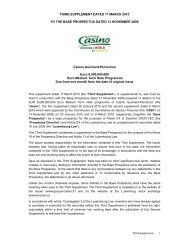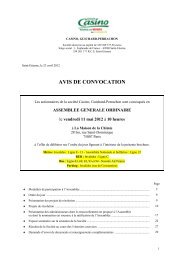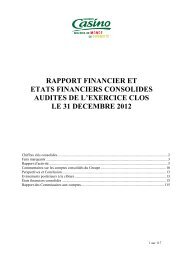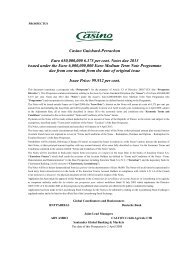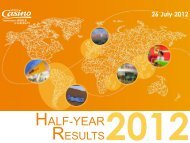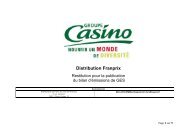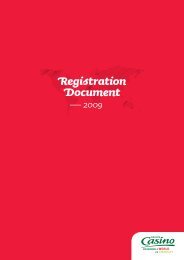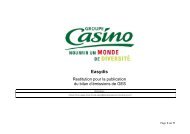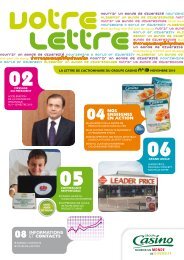2010 REGISTRATION DOCUMENT (3.4 Mo) - Groupe Casino
2010 REGISTRATION DOCUMENT (3.4 Mo) - Groupe Casino
2010 REGISTRATION DOCUMENT (3.4 Mo) - Groupe Casino
Create successful ePaper yourself
Turn your PDF publications into a flip-book with our unique Google optimized e-Paper software.
7ADDITIONAL INFORMATIONGeneral informationIn accordance with the law, the Board of Directors approves relatedparty agreements, other than those entered into in the normal courseof business on arm’s length terms, governed by Article L. 225-38 ofthe French Commercial Code (Code de commerce). In accordancewith Article L. 225-35 of the French Commercial Code, the Board’sprior authorisation is required for any and all guarantees, bonds andendorsements issued in the Company’s name. However, the Boardmay delegate this authority to the Chief Executive Officer. In thiscase, the Board of Directors will set an aggregate annual ceiling onthe Chief Executive Officer’s authority and, if appropriate, a ceilingper commitment.The Board may issue delegations of authority, grant authorisations ordelegate certain functions for one or several transactions or categoriesof transaction to any director or other person, except where this isprohibited by law.The Board of Directors has included in its Charter certain mechanismsto restrict the powers of the Chief Executive Officer (see “CorporateGovernance”).Management structureMerger of the functions of Chairman of the Board of Directors andChief Executive Officer (extract from Article 21 of the by-laws)ManagementThe by-laws allow for the functions of Chairman of the Board ofDirectors and Chief Executive Officer to be separated or combined.The Company chose the latter option on 21 March 2005.The Chief Executive Officer’s term of office is set by the Board ofDirectors at its discretion, but may not exceed three years. The termmay be renewed.The Chief Executive Officer has full powers to act in all circumstancesin the name of the Company, within the scope of the corporatepurpose and except for those powers which are specifically vestedin the shareholders in General Meeting or in the Board of Directorsunder the law. However, the Board of Directors may adopt an internalrule restricting the Chief Executive Officer’s powers (see “CorporateGovernance” for a description of the restrictions decided by theBoard). The Chief Executive Officer represents the Company in itsdealings with third parties.The age limit for holding office as Chief Executive Officer is 70. If theChief Executive Officer reaches the age of 70 while in office, he isrequired to step down at the end of his current term.The Chief Executive Officer may be removed from office at any timeby the Board of Directors. If he is removed from office without duecause, he may be entitled to compensation unless he is also theChairman of the Board of Directors.Chief Operating OfficersAt the proposal of the Chief Executive Officer, the Board of Directorsmay appoint up to five Chief Operating Officers to assist the ChiefExecutive Officer in his duties.Chief Operating Officers are appointed for a maximum three-year termand their appointment may be renewed. They have the same powersas the Chief Executive Officer in dealings with third parties.The age limit for holding office as Chief Operating Officer is 70. If aChief Operating Officer reaches the age of 70 while in office, he isrequired to step down at the end of his current term.Chief Operating Officers may be removed from office at any timeby the Board of Directors, at the proposal of the Chief ExecutiveOfficer. The Chairman, if he is also Chief Executive Officer, the ChiefExecutive Officer and the Chief Operating Officers may delegate theirpowers to carry out one or several specific transactions or categoriesof transaction.Board of Directors’ CharterThe Board of Directors has adopted a Charter describing its rulesof procedure, which add to the related provisions of the law and theCompany’s by-laws.The Charter describes the Board’s organisation and procedures, thepowers and duties of the Board and the Committees of the Board, andthe procedures for overseeing and assessing its work (see “CorporateGovernance” for a description of the Committees of the Board, therestrictions on the Chief Executive Officer’s powers and the proceduresfor overseeing and assessing the Board’s work).The Charter was last updated on 27 August 2008 to incorporate theprovisions of the law of 3 July 2008 relating to the Chairman’s reportand reference to a corporate governance code.7.1.2. APPROPRIATION OF NET PROFIT(Article 34 of the by-laws)The income statement summarises all revenues and expenses forthe year. The difference between revenues and expenses, less anydepreciation, amortisation and provision charges, constitutes the netprofit or loss for the year.After deducting any prior year losses, net profit is first used to makeany transfers to reserves required by law, and more particularly tothe legal reserve.The balance, plus any retained earnings brought forward from prioryears, constitutes the sum available for distribution. It is used to paya first dividend on shares, in an amount equal to five percent (5%)of the paid-up portion of their par value. If, in a given year, there isinsufficient profit available to pay the first dividend in full, retainedearnings brought forward from the prior year may not be used tomake up the difference.Any surplus, plus any retained earnings brought forward from prioryears as outlined above, are then available for distribution to allshareholders.However, on recommendation of the Board of Directors, shareholdersmay resolve to transfer the surplus to any ordinary or extraordinarydiscretionary reserves that may or may not be allocated for a particularpurpose.On recommendation of the Board of Directors, sums transferred toreserves may subsequently be distributed or incorporated in the sharecapital by resolution of the shareholders.224 <strong>Casino</strong> Group | Registration Document <strong>2010</strong>



